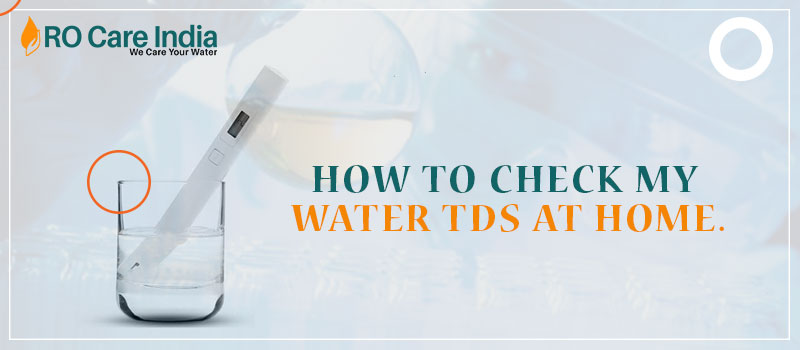Are you planning to buy a water purifier? Wait! Before buying a water purifier, check your regularly used water quality or TDS of the commonly used water because TDS has a significant role in drinking water quality. Water containing a high concentration of TDS is considered contaminated water.
Before coming to the main topic, let's discuss what TDS is and why we need to check the TDS of the drinking water? This article entitled "How To Check My Water TDS At home” will help you determine the TDS of your regular used water, thus reading this till the end.
What Is TDS?
TDS, i.e., Total dissolved Solids, measures all the inorganic and organic substances dissolved in water. Water is a universal solvent that can dissolve almost everything in it.
The common inorganic substance which can be dissolved in water is Calcium, Magnesium, and Potassium. These minerals are healthy for human health at a certain level, but any value that is more or less than an absolute value is considered unhealthy.
Why Do You Need To Check TDS?
Measuring the TDS level of water allows you to ensure whether the water you drink is pure or not. According to the BIS, the recommended TDS concentration in drinking water is 300mg/liters. A higher concentration of TDS means a high chance of waterborne diseases. Globally millions of people lose their lives due to drinking contaminated water. Thus it is recommended to drink water having low TDS.
How To Check The TDS Of The Water At Home?
Various methods can check the TDS of the water. Here we have listed the three most common methods to check the TDS at home. These methods are
#1. Using Digital TDS Meter
It is the easiest method to check the TDS of the water. The most significant advantage of using a digital meter is that you need not perform any mathematical calculation or take the reading. This method gives you instant results.
Step To Follow For Measuring TDS Of Drinking Water
Step 01: Remove the protective cap and switch on the meter
Step 02: Immerse the TDS meter in the sample water up to the maximum immersion level. There are marking on the TDS meter to indicate immersion level
STEP 03: If air bubbles are present in the water, then gently stir the digital meter to remove those air bubbles
Step 04: Wait for 10-15 seconds after placing the digital meter so that the actual reading of the TDS concentration can be recorded
Step 05: Some digital meter represents the value after multiplying it by 10, but in some, you need to multiply the recorded value by 10
Step 06: After measuring the TDS reading of the water, shake off the excess water from the digital meter and replace the protective cap
Precaution needs To Be Taken While Using Digital TDS Meter
- Digital TDS is not watertight. Thus you need to ensure not to dip the meter beyond the maximum immersion level
- Ensure not to expose the meter to direct the sunlight
#2. Using Electrical Conductivity Methods
This method releases electrical current into the water and measures its resistance.
Apparatus Required For Electrical Conductivity Methods
- A sterilized glass beaker ensure the glass is entirely dust-free
- An electrical conductivity meter
- The water sample should be around 250C
Steps To Measure The Electrical Conductivity
- Place the glass beaker at the flat surface, switch on the conductivity meter and insert the measuring leads in the water
- Allow the reading to get settled and take the proper reading. Initially, it will fluctuate, and after that, it will get settled
- The water conductivity indicates the purity of the water, so the lower the water electrical conductivity, means purer the water is.
Calculate TDS Using Below listed formula
TDS (mg/l)= KE * EC
KE= Co-relation Factor
EC= Conductivity
Also Read- Best Water Purifier For Home In India 2022
#3. Using Filter Paper And A Scale
This is one of the conventional methods for measuring the TDS of the water. Using this method, you can quickly determine the TDS of the water, and for this, you need not buy any product. Below we have listed some of the crucial steps you need to follow while determining the TDS of the water. But before this, let's discuss the apparatus required for the following processes
Apparatus Required
- A clean and sterilized glass beaker or container
- Water sample for measuring TDS of the water
- Filter paper. You can also use multiple layers of cotton clothes
- Evaporating dish
- A sterile stirring stick
- Pipette large enough to collect a minimum of 50 ml of water
- A weighing scale or machine
Steps To Be Followed
Step 1. Weigh The Empty Evaporating Dish
Using the weighing scale, weigh the empty evaporating dish and ensure that the evaporating dish is completely dry and free from any extraneous matter. After weighing the evaporating dish, note down the reading in mg.
Step 2. Stir The Water Sample
Stir the water sample vigorously. Stirring of water sample ensure that all the particular matter present in water dispersed equally throughout the water sample
Step 3. Collect The Water Sample
With the help of the pipette, collect water samples, but make sure that you have taken at least 50 ml of the water sample. While collecting water samples, make sure that no particular matter settles in the container's bottom, thus continuously stirring the water. If particulate matter is not equally distributed, the reading will not be accurate.
Step 4. Extract The Filtrate
Pour the water sample through the filter paper in the other container. Repeat this process three times to ensure that the whole particulate matter collection is in the filter paper.
Step 5. Weight The Evaporating Dish With The Filtrate
Transfer the entire filtrate to the evaporating dish and allow it to dry completely. Once it gets dry, weigh the evaporating dish and the filtrate and note down the reading in mg.
Step 6. Calculate The Value Of The TDS In Water Sample
To calculate the actual value of the TDS, use the given formula
TDS= (A-B) *1000/ water sample taken in ml
Here
A= weight of the evaporating dish and filtrate
B= weight of the evaporating dish alone
A water sample is taken in ml= This represents the value of the water sample you have taken. For example, if you have taken 50 ml of water as a sample, the value of the water sample taken in ml is 50.
Precaution To Be Taken
- Carefully weigh the evaporating dish and also the evaporating dish with the filtrate
- Wait for the filtrate or particle to dry before you filter it by using filter paper completely
Note- Most people are confused between TDS level and hardness. High TDS does not always mean that your water is hard. If you want to determine the water's hardness, you should perform a test.
What Is Good TDS For Drinking Water?
Natural solvent water can dissolve almost everything, making water home for various kinds of substances. This is the reason why the water has a high TDS value. But the question is how much TDS is suitable for drinking. According to the BIS, i.e., Bureau Of Indian Standard water having 300 mg/liter TDS are suitable for drinking purposes, but the maximum permissible TDS concentration in water is 600mg/liters.
According to the WHO, water having a TDS level less than 300 mg/liters are suitable for drinking, but water having TDS greater than 1200 mg are not acceptable for drinking purpose.
|
TDS Value (mg/liter) |
Rating |
|
TDS less than 300 |
Excellent For Drink |
|
300-600 |
Good for drinking purposes |
|
600-900 |
Fair |
|
900-1200 |
Poor |
|
1200+ |
Entirely unsafe for drink |
Is Low TDS Water Harmful?
TDS reflects the value of unwanted substances in the water and the actual meaning of TDS is total dissolved solids in the water. It means TDS represents the value of both wanted and unwater material or salts present in the water. But both high and low values of the TDS are crucial. According to the various expert's water having 50-150 mg/liter TDS concentration is suitable for drinking purposes. Although according to the BIS, water having TDS up to 300mg/liter is suitable for drinking purposes.
Is 30 TDS Water Is Safe For Drinking?
No, water having TDS less than 50mg/liter is not suitable for drinking purposes as it lacks wanted and desirable nutrients. Here we have tabulated how much TDS in water is suitable for drinking purposes.
|
Level Of TDS (ml/liter) |
Remark |
|
<50 |
Not acceptable for drinking purposes may lack essential minerals |
|
50-150 |
Water has TDS 50-150 are ideal for those areas where water is polluted by sewage and Industry waste |
|
150-350 |
Good. This TDS level in water is suitable for those who are suffering from cardiovascular disease |
|
350-500 |
Fairly accepted for drinking |
|
500-900 |
Less acceptable for consumption |
|
900-1200 |
Poor |
|
More then 1200 |
Not permissible |
Drinking water is the basic need for all people to live as water participates in almost all the body's functions, such as eliminating waste material, improving digestion, keeping the circulatory system healthy, and improving the brain's functions. But all the time, you need to ensure that you are consuming contamination-free water.
Due to increasing water pollution getting contamination-free water is challenging. With the help of the water purification system, you can get entirely pure and contamination-free water all the time you urge to drink water. Water purification eliminates the contamination present in water, but it also improves the taste of the water by reducing the TDS level in the water.
Share this information with your friend and family, so provide them with knowledge about how to check the TDS concentration of the water. Also, if you know more methods to calculate the TDS of the water, then feel free to comment.
You may need RO Service in these Cities:
RO Service in Amroha | RO Service in Azamgarh | RO Service in Ballia | RO Service in Bijnor | RO Service in Faizabad | RO Service in Muzaffarnagar | RO Service in Rae Bareli | RO Service in Sultanpur









